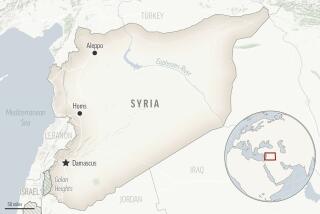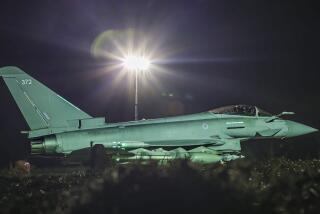Syria military launches assault on key district in Aleppo
BEIRUT — The Syrian military launched an assault Wednesday on a strategic and highly symbolic rebel stronghold in the northern city of Aleppo, signaling a major government effort to reassert control of the nation’s commercial hub.
There were conflicting accounts about which side, if either, had the upper hand.
Syrian state television reported that the government had assumed “full control” over Aleppo’s Salahuddin district, the target of weeks of military bombardment.
It reported the deaths of many “terrorists,” the government’s label for the armed rebels fighting to oust President Bashar Assad.
However, rebel commanders and opposition spokesmen said the battle was still raging and denied that insurgents had pulled back from Salahuddin.
“Our boys are still there,” said Mahmoud Sheik Elzoor, a rebel commander reached by telephone in Turkey. “What the government is saying is not true.”
In a video posted online, a commander from the rebel Tawheed Brigade vowed, “We won’t leave here till we die.”
The frontline neighborhood, parts of which have been reduced to rubble by the bombardment, is both a strategic entry point to Syria’s most populous city and a touchstone of the rebellion in Aleppo.
For months, while much of Aleppo was quiet, Salahuddin was a center of antigovernment protests. Many residents of the working-class district trace their ancestry to nearby rural areas, where opposition to Assad’s government is intense.
Most inhabitants have fled Salahuddin since the fighting began almost three weeks ago. Some have escaped to nearby Turkey, joining an exodus that has accelerated in recent days.
The opposition has repeatedly vowed not to abandon Salahuddin, eschewing the “strategic withdrawal” tactic often used in guerrilla warfare. Early this year, rebels executed such a withdrawal from the Baba Amr district of Homs, which, like Salahuddin, endured barrages of government shelling and became a symbol of the opposition.
It was unclear whether the government assault Wednesday represented the army’s long-awaited all-out onslaught or was a limited foray focusing on the Salahuddin area.
On paper, the clash between the two sides appears a mismatch. The government has professional troops, tanks and aircraft at its disposal against ill-trained rebel formations mostly armed with rifles and rocket-propelled grenades. Rebels lack heavy weapons and say they are running low on ammunition.
Salahuddin is in the southwest quadrant of the city, next to the Hamdaniyeh district, where the opposition says scores of government tanks are stationed. On several previous occasions, rebels had reported beating back tank-led attacks on the neighborhood.
Many analysts say Assad cannot afford to lose Aleppo.
“Aleppo means more for the government than it does for the rebels,” said Andrew Exum of the Center for a New American Security, a Washington think tank. “The rebels are playing a long game here. They are waging a guerrilla campaign. They don’t have to control Aleppo. But the government does.”
A rebel victory in Aleppo could open up much of northern Syria to opposition control, with clear supply lines into Turkey.
In Washington, President Obama’s counter-terrorism advisor said publicly for the first time Wednesday that the administration was studying the possibility of creating a no-fly zone in Syria to prevent airborne attacks on civilians, as well as other steps toward some form ofU.S. military involvement.
In an appearance at the Council on Foreign Relations, John Brennan said various options were being looked at “very carefully.”
Asked specifically whether a no-fly zone was under consideration, Brennan said, “I don’t recall the president saying that anything was off the table.”
Creating a no-fly zone over Syria would face considerable hurdles in the political and security realms. Russia, long an ally of Assad, would probably object to any effort to win U.N. approval for such a plan. Meanwhile, Syria’s antiaircraft capabilities are said to remain robust and would have to be neutralized in what could be a long bombing campaign.
As clashes intensify in Aleppo, human rights groups say a humanitarian catastrophe may be unfolding in the city.
More than 200,000 residents have already fled, according to the United Nations, and frontline districts are said to be largely devoid of civilians. Authorities in Turkey have reported a steep rise in the number of refugees entering the country. More than 2,000 Syrians arrived at the border Wednesday, said Turkey’s official Anatolia news agency.
In Aleppo and its outlying districts, thousands of displaced people are said to be sleeping in schools, mosques and parks. Long lines have formed for bread, and supplies of cooking oil are scarce, witnesses say. Prices have risen sharply.
But Aleppo is a large and sprawling city and some districts have remained largely unaffected. The fear of many residents is that the fighting will spread and engulf much of the metropolitan area.
In Jordan, meanwhile, the Associated Press quoted Jordanian officials and a spokesman for the rebel Free Syrian Army as saying Syrian Prime Minister Riyad Farid Hijab had completed his defection by crossing the border at dawn Wednesday after two days of hiding in Syria.
They described an operation that involved deceiving the news media into reporting that Hijab had already made it to Jordan so that Syrian officials would stop looking for him. He reportedly crossed with 35 family members, including his wife and children, seven brothers and two sisters and their families.
Times staff writer Paul Richter in Washington and a Times staff writer in Beirut contributed to this report.
More to Read
Start your day right
Sign up for Essential California for news, features and recommendations from the L.A. Times and beyond in your inbox six days a week.
You may occasionally receive promotional content from the Los Angeles Times.






